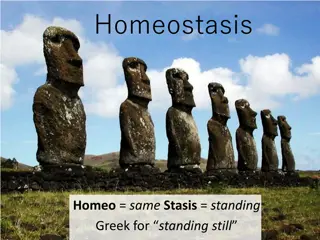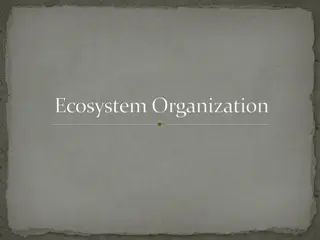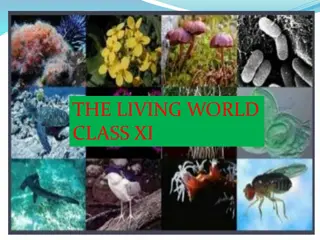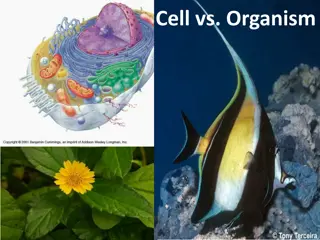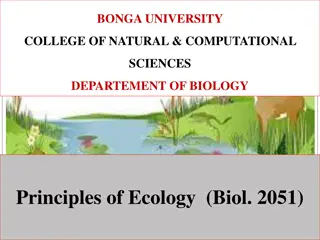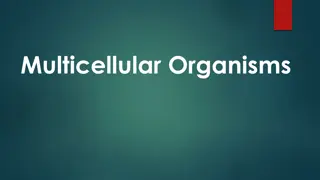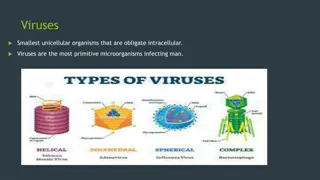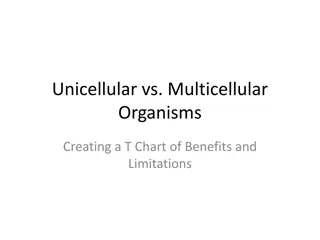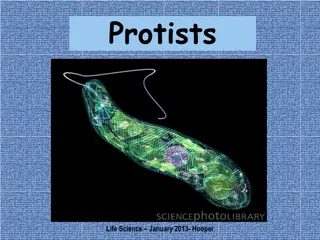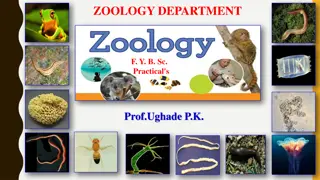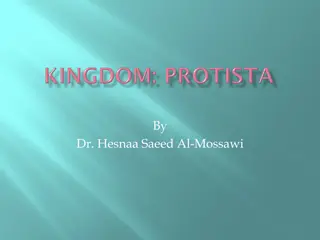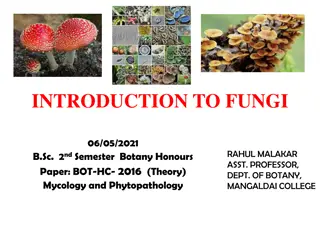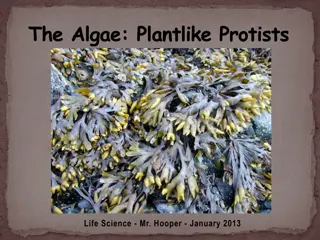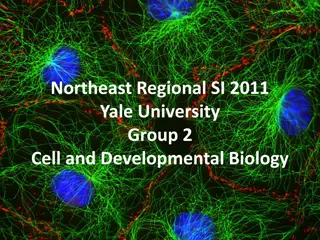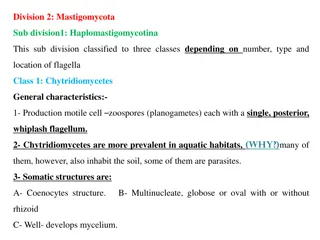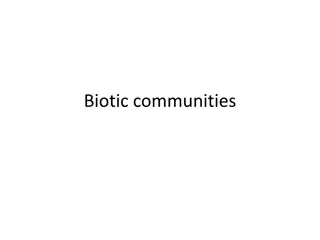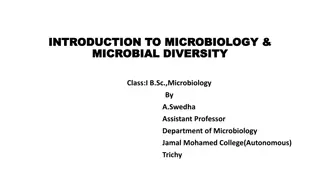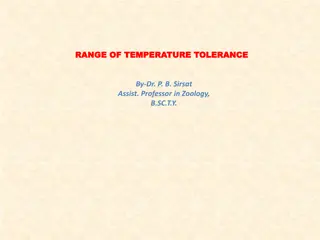Implementing Personal Protective Equipment in Nursing Homes for Preventing XDROs and MDROs
Learn from infection prevention consultant Karen Trimberger about implementing enhanced barrier precautions in nursing homes to prevent the spread of extensively drug-resistant organisms (XDROs) and multidrug-resistant organisms (MDROs). Explore the difference between colonization and clinical infec
6 views • 33 slides
Understanding Ecology: Interactions Between Organisms and their Environment
Ecology is the scientific study of how living organisms interact with each other and their environment. It delves into the relationships between biotic and abiotic factors, encompassing topics such as the distribution and abundance of organisms, structural adaptations, behavior under natural conditi
2 views • 42 slides
Understanding Ecosystems: Ecological Interactions and Dependencies
Ecology is the study of how organisms interact with their environment, influencing their distribution and abundance. This exploration covers terrestrial and aquatic biomes, energy flow, environmental impacts, adaptations, and global ecosystems, emphasizing the interconnectedness of all living organi
2 views • 58 slides
Understanding Homeostasis in Living Organisms
Homeostasis, derived from Greek meaning "standing still", is crucial for maintaining balance in living organisms. It involves regulating internal variables to prevent disease or death. Ancient Greeks emphasized the importance of harmony and equilibrium in life. Claude Bernard and Walter B. Cannon fu
1 views • 29 slides
Understanding Levels of Organization in Living Organisms
Explore the levels of organization in living organisms, from atoms to cells, and the differences between unicellular and multicellular organisms. Learn about prokaryotes, eukaryotes, cell differentiation, chromosomes, and the importance of stem cells in development and repair.
0 views • 17 slides
Exploring Unicellular Organisms: Amoeba and Euglena Structures and Characteristics
Journey into the microscopic world of unicellular organisms with a focus on Amoeba and Euglena. Discover the unique structures and behaviors of these tiny creatures, from Amoeba's adaptable pseudopod movements to Euglena's photosynthesis capabilities. Uncover how these organisms survive, feed, and r
0 views • 15 slides
Understanding Living Things: An Overview of Classification
Living things share common characteristics like being made of cells, responding to the environment, and reproducing. Macromolecules in cells help them function, and unicellular and multicellular organisms differ in structure. The levels of organization in multicellular organisms are explained, along
0 views • 18 slides
Adaptations for Efficient Material Exchange in Organisms
Understanding how cells and organisms adapt for effective material exchange through diffusion, surface area to volume ratio, and specialized exchange surfaces. Larger organisms require specialized structures for efficient exchanges, in contrast to smaller organisms that can rely on simple diffusion.
0 views • 19 slides
Understanding Ecosystem Organization and Hierarchy
Explore the intricate relationships within ecosystems through the study of organization and hierarchy. From individual organisms to complex communities, learn how biotic and abiotic factors shape these environments. Gain insights into the levels of ecosystem organization, from single organisms to in
5 views • 15 slides
Understanding the Characteristics of Living Organisms
Life is a unique biochemical process expressed through chemical reactions leading to growth, development, responsiveness, adaptation, and reproduction. Living organisms exhibit characteristics such as growth, definite shape and size, reproduction, metabolism, and cellular organization. These traits
4 views • 32 slides
Understanding Gas Exchange in Cells and Organisms
Gas exchange is vital for cellular respiration and photosynthesis. In organisms, specialized structures like alveoli in lungs and stomata in plants facilitate this process. This exchange occurs through diffusion across moist surfaces with large surface areas. In animals, oxygen is taken up by hemogl
0 views • 40 slides
Fundamentals of Taxonomy Explained: From Classification to Nomenclature
Taxonomy, derived from Greek roots, encompasses the science of classifying organisms and understanding their variations, evolutionary relationships, and naming conventions. It involves description, identification, classification, and nomenclature of both living and extinct organisms. The practices o
1 views • 39 slides
Understanding Biosynthetic Pathways in Living Organisms
Biosynthesis, also known as anabolism, involves the formation of complex organic compounds from simple subunits catalyzed by enzymes within living organisms. This process is vital for the development of life and the production of essential compounds like carbohydrates, proteins, vitamins, antibiotic
1 views • 21 slides
Principles of Ecology: Understanding Organism-Environment Interactions
Ecology is the scientific study of how living organisms interact with each other and their environment. It involves understanding organisms at their native habitats, from individuals to ecosystems. The discipline encompasses various branches and focuses on the relationships shaping the distribution
1 views • 14 slides
Exploring Genetic Engineering: A Journey into Manipulating Organisms
Delve into the world of genetic engineering, where organisms' genetic makeup is altered for various purposes. Discover the process of modification, the history of genetic manipulation, and the impact of genetically modified organisms on society and science.
0 views • 20 slides
Exploring Multicellular Organisms: Structures and Functions
Learn about multicellular organisms, including examples like humans, animals, and plants, and how their cells, tissues, organs, and systems work together to perform various functions. Understand the difference between single-celled and multicellular organisms and why some require specialized cells t
0 views • 15 slides
Reproduction in Organisms: Overview and Types
Understanding the concept of reproduction in organisms, this content delves into the different modes of reproduction such as asexual and sexual, with examples and illustrations. It covers the life spans of various organisms and details various methods of asexual reproduction like fission, budding, s
0 views • 23 slides
Understanding Viruses: Basics and Morphology
Viruses are the smallest unicellular organisms that are obligate intracellular. They lack cellular organization like bacteria, and their multiplication is complex. Viruses have either DNA or RNA and are classified based on their nucleic acid. Their structure includes nucleic acid and a capsid compos
0 views • 29 slides
Unicellular vs. Multicellular Organisms: A Comparative Analysis
Unicellular and multicellular organisms differ in structure, division of labor, specialization, exposure to environment, response to injury, size limitations, lifespan, and ability to divide. Unicellular organisms have a single-cell body, limited operational efficiency, and face challenges in size a
0 views • 12 slides
Understanding Ecosystem Dynamics: The Food Web Explained
An ecosystem comprises various organisms living together in a community. Energy flow through food chains depicts how organisms obtain energy and nutrients from one another. Food chains show the sequence of feeding relationships, while a food web illustrates interconnected chains within a community.
1 views • 13 slides
Understanding Relationships Between Organisms in Nature
Explore the various relationships between organisms in nature, including intraspecific and interspecific interactions such as competition, predation, and parasitism. Learn how organisms compete for resources, hunt and protect themselves, as well as how parasites survive on host organisms. Delve into
2 views • 13 slides
Exploring the World of Protists: A Kingdom of Diversity
Protists are eukaryotes that cannot be classified as plants, animals, or fungi. They thrive in moist environments and showcase a remarkable diversity within the Kingdom Protista. From animal-like protozoa to plant-like autotrophs and fungus-like heterotrophs, this kingdom contains a wide array of un
0 views • 18 slides
Classification and Characteristics of Phylum Protozoa
Phylum Protozoa comprises unicellular, microscopic, eukaryotic organisms found mostly in aquatic habitats. They exhibit diverse locomotory structures such as cilia, flagella, or pseudopodia. These protists may possess a cellulose cell wall and various membrane-bound organelles like mitochondria and
0 views • 21 slides
Unveiling the World of Unicellular Organisms
Discover the fascinating world of unicellular organisms through examples like Amoeba and Paramecium. Compare the characteristics and functions of unicellular and multicellular organisms, explore their feeding, movement, waste removal, and reproduction processes, and delve into the diversity of cell
0 views • 14 slides
Understanding Protozoa: The Animal-Like Unicellular Organisms
Protozoa are unicellular heterotrophic organisms that obtain nutrition by ingesting other organisms or dead organic material. They can be parasitic and are classified based on their modes of locomotion. Common groups include amoebas, flagellates, sporozoans, and ciliates. Protozoa are further catego
0 views • 16 slides
Understanding Unicellular and Multicellular Organisms in Biology
Explore the basic differences between unicellular and multicellular organisms, including the distinctions between prokaryotes and eukaryotes. Unicellular organisms, such as bacteria and amoeba, consist of a single cell and are often microscopic. Examples of both prokaryotic and eukaryotic unicellula
0 views • 10 slides
Understanding Taxonomy and Classification in Biology
Scientists use classification to group organisms logically, making it easier to study life's diversity. Taxonomy assigns universally accepted names to organisms using binomial nomenclature. Carolus Linnaeus developed this system, organizing organisms into species, genus, family, order, class, phylum
0 views • 11 slides
Understanding Protists: Unicellular Organisms and Their Classification
Protists are diverse unicellular organisms that can be classified based on their nutrition and movement methods. They include protozoans, algae, and heterotrophs like molds, each playing unique roles in ecosystems. From Didinium to multicellular algae, explore the fascinating world of these microsco
0 views • 8 slides
Understanding the Classification of Living Organisms
Living organisms are classified into five kingdoms, each further divided into smaller groups called phyla, classes, orders, and genus. The five kingdoms are Monera, Fungi, Protista, Plantae, and Animalia. Animals are categorized into invertebrates and vertebrates, with significant agricultural impor
0 views • 50 slides
General Characteristics of Fungi and Mycology Overview
Fungi, diverse eukaryotic organisms, exhibit various characteristics such as heterotrophic nature, distinct cell wall composition, and different modes of reproduction. Mycology, the study of fungi, delves into their classification and functions. Fungal cells may be unicellular or filamentous, with m
0 views • 15 slides
The Fascinating World of Algae and Protists
Algae, diatoms, dinoflagellates, euglenoids, and red algae are diverse plant-like protists crucial for Earth's ecosystems. They range from unicellular to multicellular forms, contributing significantly to oxygen production and food chains. While some like red algae thrive in deep ocean waters, other
0 views • 20 slides
Understanding Algae: Classification, Habitat, and Reproduction
Algae are chlorophyllous thallophytes that thrive in aquatic environments, producing their own food and oxygen through photosynthesis. They are categorized based on habitat as aquatic, terrestrial, aerophytes, cryophytes, and thermophytes. The three main classifications of algae are Chlorophyceae (g
0 views • 16 slides
Intestinal Helminths: Classification, Nematodes, and Common Infections
Intestinal helminths, including nematodes, are classified into unicellular and multicellular parasites. Nematodes are elongated worms found in the human body, causing common infections such as Enterobius vermicularis. The pathology of Enterobius infections often presents with pruritus ani. Learn abo
0 views • 53 slides
Understanding the Significance of the Cell Cycle in Growth and Development
This resource focuses on the cell cycle in the context of growth, development, and proliferation. It covers the significance of cell division, similarities in unicellular and multicellular organisms, the importance of CDK-mediated phosphorylation, and more. Students will learn to create schematic de
0 views • 24 slides
Understanding Cellular Respiration and Fermentation Processes
Cellular respiration is the energy-releasing process in which organisms take in glucose and oxygen to produce carbon dioxide, water, and energy. This process is vital for all living organisms. Photosynthesis and respiration are opposite processes, with respiration requiring the products of photosynt
0 views • 10 slides
Diversity and Life Cycles of Mastigomycota Subdivision Haplomastigomycotina
Mastigomycota Subdivision Haplomastigomycotina comprises diverse classes, including Chytridiomycetes, classified based on flagella characteristics. Chytridiomycetes are motile in aquatic habitats, with some exhibiting parasitic behavior. The subclass Chytridiales includes unicellular organisms with
0 views • 9 slides
Understanding Heterotrophic Nutrition in Organisms
Heterotrophic nutrition refers to the process where organisms, such as animals, rely on preformed organic molecules from their environment or other organisms for nutrients and energy. These organisms are unable to produce organic compounds from inorganic sources and must obtain nourishment from exte
0 views • 55 slides
Understanding Biotic Communities and Benthic Ecosystems
Living organisms in an area form biotic communities categorized into producers, consumers, omnivores, detrivores, and decomposers. Aquatic organisms such as plankton, benthos, and nekton play vital roles. Benthic communities refer to organisms attached to or burrowing in aquatic ecosystems, influenc
0 views • 17 slides
Exploring Microbial Diversity: Fungi in Microbiology
Microbes are vital single-celled organisms that exist everywhere, some beneficial while others harmful. Fungi, a crucial group of microbes, can be unicellular or multicellular, with diverse roles in nature and human activities. This article delves into the characteristics and classification of fungi
0 views • 15 slides
Temperature Tolerance of Organisms in the Universe
Life on Earth exists within a range of temperatures, with organisms displaying varied temperature tolerance. Eurythermal organisms can withstand large temperature fluctuations, while stenothermal organisms tolerate only small variations. The temperature range for each species is crucial for their ph
0 views • 8 slides



